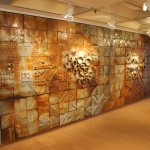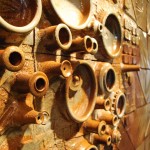

After attending the École des beaux-arts de Montréal from 1959 to 1961, Jacques Hébert was initiated to ceramic arts by Claude Théberge. Then, for a dozen years, he was the master craftsman for muralist Jordi Bonet, with whom he produced numerous large-scale projects, including for La Place des arts de Montréal, Expo 67, Le Grand Théâtre de Québec, and many others in the United States and Canada. In the late 1970s, after a stint in the studio of Roland Gingras, Hébert co-founded a press agency and turned to design; later, he took up cabinetmaking.

Artwork description
The artwork consists of a large stoneware mural made by hand by the skilled artist. Its placement in a central hallway that provides access to various exhibition spaces in the cultural centre puts it in proximity to visitors, who have an opportunity to examine its various details.
The mural is made of 198 blocks forming an abstract composition in earthy colours. By accentuating the different textures, the artist wanted to symbolize the theme chosen by the architect, “Living in the City.” The artwork is therefore divided into three main sections, from an aerial point of view: the evolution of past, present, and future housing models. The many diagonals that punctuate the reading of the work represent the proliferation of communications systems characterize urban life.
This project of integration with architecture is the only one that Hébert produced in his own name, although he long assisted Jordi Bonet in creating similar murals.



